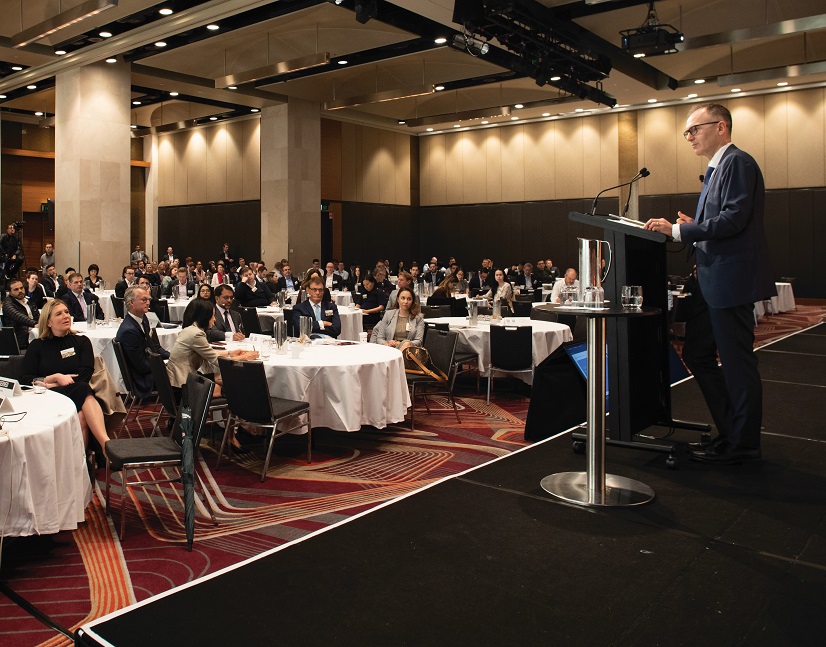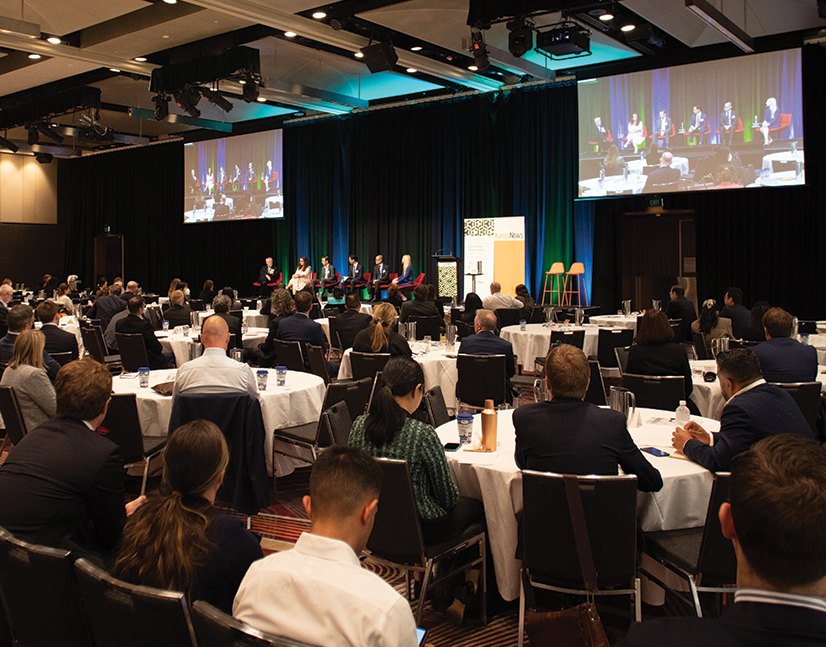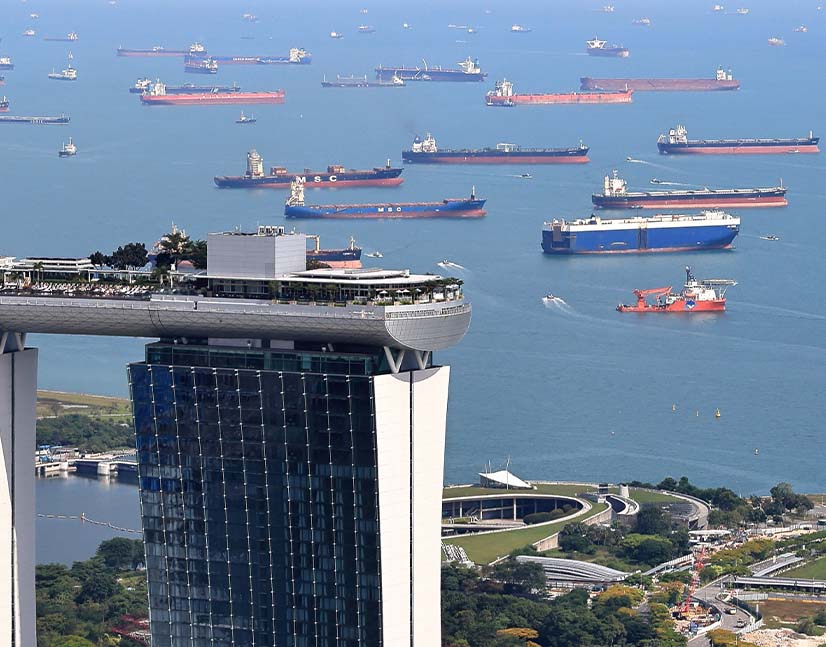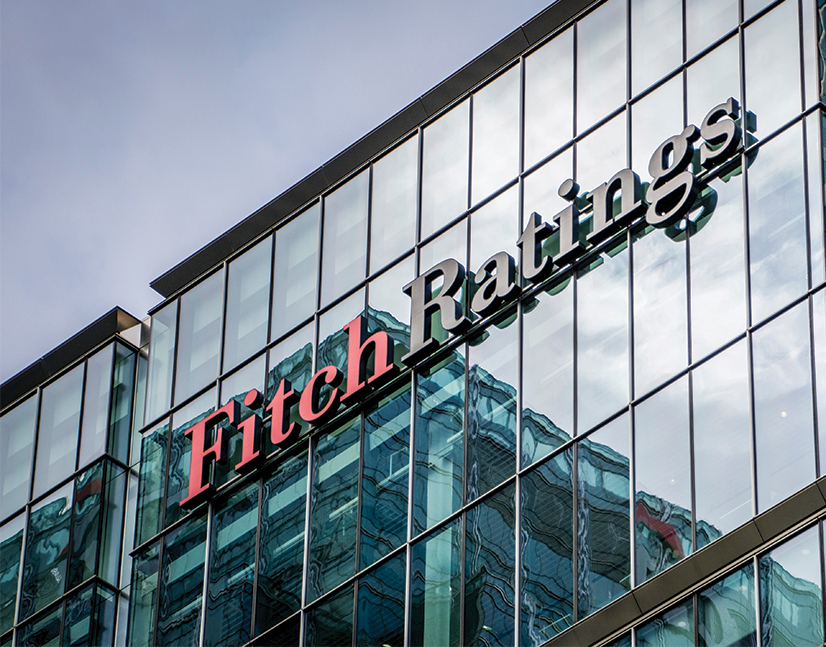
Corporate Australia should be rewarded for cautious approach and economic resilience
After a year of limited capital market issuance – domestically and offshore – there might be grounds for pessimism in the Australian corporate debt market. But a group of analysts, issuers and investors who gathered at a discussion hosted by Fitch Ratings and KangaNews in November 2022 say Australian credits are relatively well positioned as and when confidence returns to the market, despite the obvious challenges of the past year.
MACRO OUTLOOK
Davison What hints does the big picture in the Australian economy provide about the local credit sector?
ZOOK It is still a very volatile and uncertain time in the global economy. Australia is relatively insulated from a lot of the negative headwinds but it will still be affected. The key themes we are dealing with are slowing global growth, very high inflation and, of course, rapidly rising interest rate settings. These are all being exacerbated by significant geopolitical risk, in particular the conflict in Ukraine. It is still a very risky environment globally.
For Australia, we forecast relatively robust growth of 1.9 per cent in 2023 and 2.1 per cent in 2024. This is still quite a slowdown from where we are now and the risks are tilted very much to the downside.
The global context is a quite challenging environment: Fitch Ratings is forecasting a modest recession in the US and a slightly deeper recession in the euro area. Of particular importance for Australia, our outlook for China is on the weak side – we forecast a small rebound in China, to growth of about 4.5 per cent in 2023 from 3 per cent in 2022. But we see a lot of uncertainty given China’s zero COVID-19 policy and the uncertain exit from it.
More specific to Australia’s iron ore exports, construction starts have come down quite dramatically in China. The authorities have taken some steps to try to contain the fall in property prices and construction, but our outlook is quite weak. In the past, China’s rate of growth has been an offsetting factor for Australia when there have been large shocks in the US and Europe. This time around it might not be as strong an offset for Australia.
On the other hand, Australia is a commodity exporter and commodity prices are performing very well in the current environment, especially coal and liquified natural gas. Overall, Australia is seeing more positives than other advanced economies.
On the domestic front, the challenges are similar to the US and other advanced economies: very high inflation driving central banks to tighten policy quickly. In Australia, this will feed through to household consumption rather quickly given the structure of mortgages. High inflation eats into real wages and higher debt servicing costs will constrain households.
A few factors set Australia apart and provide a bit more resilience. Households still have pretty strong savings buffers. They may be drawing on these savings at the moment but they are still relatively high compared with pre-pandemic levels. Labour markets are tight everywhere but particularly so in Australia, where the participation rate is at around historic highs. Strength in the labour market should provide some resilience on the consumption front.
As to the outlook for the policy rate, at Fitch we expect only one more 25 basis point hike in [December] 2022 and for the Reserve Bank of Australia (RBA) to remain on hold thereafter. There is certainly some upside to this forecast and we could see more upward momentum in rates in Q1 next year.
We have a more sanguine outlook on inflation: we expect it to peak in the final quarter of 2022 and then recede to about 3 per cent in 2023. Wage growth is picking up but not to the point where we think wage-price spiral worries are a large concern. This gives the RBA more space to keep the pace of its hikes more moderate than others.
We affirmed Australia’s sovereign triple-A rating in April 2022, with a stable outlook. We had Australia on negative outlook during the pandemic because of the sharp rise in government debt, but we stabilised this about a year ago. Going forward, we expect the government will be able to stabilise and bring down the debt ratio over the medium term. If this becomes more challenging it would put more pressure on the sovereign rating.
Over the medium term, the recent federal budget highlighted a lot of the fiscal challenges and spending pressures Australia will face. In our view, this will be more challenging for the rating over the longer run. We are also quite focused on the issues of household debt and rising interest rates. But we think they will be a headwind to economic growth rather than financial stability. A sharp rise in unemployment would certainly become more challenging, though.
“Corporate issuers are staying away from the Australian market because it is the sensible choice, not because they do not like the market or do not want to return to it. If I were an issuer, I would be drawing down on my cheaper revolvers today rather than getting set for seven years in the Australian market at 6 per cent.”
Davison If Australia is going to succeed in matching the soft landing path the RBA appears to anticipate, it may have to do better than many other economies. Europe has deep problems with the war in Ukraine and the energy crisis, while the US and even New Zealand have experienced more aggressive policy moves. Are the pieces really in place for Australia to avoid aggressive hiking and a significant recession?
ZOOK In our baseline, yes – although the risks are rising. Globally, there are signs that inflation is perhaps beginning to peak, particularly on the goods side, as some supply constraints start to ease. Domestically, we have not quite experienced the same degree of wage pressure as seen in the US, Europe and in New Zealand.
These factors set Australia apart from other countries – but the risks are probably tilted to the upside. If inflation is more persistent, the RBA will have to continue to act.
JANSCHEK We are relatively optimistic about the prospects for a soft landing – and this goes for the US as well. We can see that data are deteriorating but the labour market still seems to be pretty strong, as it does here.
The “Fed put” nowadays really seems to be the labour market. In other words, rates are going up at a fast pace and are starting to stress test the economy, so the fact that people can still have a job and pay their bills is extremely important not only to the outlook but also to the RBA’s reaction function.
As for Australia, we have a lot of ticks in a lot of boxes. The RBA seems to be pretty optimistic: it still expects growth – albeit of less than 1.5 per cent – in the next couple of years. This really is a pretty sanguine outlook given the pace of rate hikes so far.
Regarding the macro influence on the market, it is enormously important that central banks have started to talk about tapering incremental rate hikes in the past couple of months. The Fed has been clobbering investors with 75 basis point hikes every six weeks.
This takes the buy side out of the market at a time when investors would typically emerge to accumulate bonds and earn carry, and effectively removed the market’s self-equilibrating system. Price changes have been so large that they effectively relegate carry to an irrelevance.
It is understandable that bond markets have been as unstable as they have and it also follows that the RBA, the Fed and the European Central Bank are talking about being more accommodative in the way they approach policy. Markets hate uncertainty but the central banks are now providing some degree of certainty, in the sense that they understand data are weakening and they are not going to tighten economies into oblivion.
This means demand and supply in markets is starting to get closer to equilibrium, and new issuers are coming back to the market. SSA [supranational, sovereign and agency] issuers in Australia, for example, have found a window as the banks start to push their issuance offshore and the basis swap starts to work for all parties.
“We expect funding pressure will come through more gradually as and when maturities come up. Further, the increase may also not be as great as it appears at face value. If the debt that needs to be refinanced was issued before the period of low interest rates, the differential delta in funding cost may be lower than the movement in official interest rates.”
Fast forward 12 months
Few would have predicted at the end of 2021 exactly how the following year would unfold in capital markets. Even so, participants at the Fitch Ratings-KangaNews roundtable offer their best guesses about the agenda 12 months hence.
VANDELIGT Next year the question will be what is the long-term level of interest rates. If inflation is starting to slow, or at least the pace of increases is slowing, by this time next year we will be wondering if rates will start to fall or stay at an elevated level.
TRIGONA I think rates will be elevated throughout 2023. I do not think we will have a rate cut next year – 2024 will be when we start to see them.
AMATO For debt issued before the pandemic, 4-5 year tenor is starting to come up for refinancing over the next year or two. Whether or not there is any liquidity stress in the market is something we will be looking for.
JANSCHEK We may get into 2023 and find the market is a lot more stable than this year, but by the time we get to the end of it I agree that rates will still be higher. I suspect we will be surprised at how well we have adapted to them, however, and that business is actually picking up. Issuance will probably do a lot better as well.
Then, moving into 2024, it will be a case of having got used to higher rates so much that inflation cannot get back to target, or cutting rates because the economy is slowing up sufficiently. Next year might be much more stable, but 2024 will be a different story.
MUDELIAR I expect rates will stabilise, but probably not as high as people expect. On a slightly more positive note, we are already seeing the return of the workplace sector in our businesses and I believe we will see even more of it. We are going to see a return to the city, so inner city residential will be a winner.
HODGES The key themes will remain the stickiness or the persistency of inflation and how high it will stay for how long, versus the interest rate environment and whether the terminal rate is marginally higher than what we see now or has to increase further.
The extent to which central banks are willing to tighten the screws will depend on economic conditions and, specifically, whether we have a slowdown or a recession-type environment.
ZOOK We forecast a rate cut in 2024, so I imagine this will be the big theme a year from now. Central banks are going to tighten their policy rates above the long-run neutral rate, so monetary conditions will be quite tight. As the economy slows, there will be a case for easing. Inflation will not yet be in the target band, but it is more about the outlook for inflation – it will be coming down. Given tighter monetary settings, central banks will perhaps be a bit more confident about getting back into the target band.
LEWIS Once rates find their peak they are expected to stay there for some time while conditions settle down. The unemployment rate will most likely start edging higher but there will not be stimulus while inflation remains a concern. Globally, we will be conscious of what is happening in the US and Europe regarding predictions of recession.
AUSTRALIAN CREDIT
Davison Australian corporate credit quality is seldom a major concern for investors, whereas lack of liquidity and volatility sometimes are. Economic levers have shifted, however. Is Fitch encountering stress points among the issuers it covers?
HODGES The outlook for transportation infrastructure credits will remain neutral for 2023. Within this, it is likely the airport subsector will be improving – but a neutral outlook overall reflects the slowing economic growth backdrop we forecast for 2023.
At a more granular level, a number of credits still face ongoing supply chain disruptions – although these appear to be abating globally – and a rising interest rate environment that is a headwind in some cases. This is largely offset by strong sector fundamentals for toll roads, ports and airports. On airports, the improving outlook reflects the expectation of continued recovery in international passenger traffic in 2023, although we do not anticipate a full recovery until the end of 2024.
We are focused on three things that could knock future projections off course. First and foremost is a more pronounced economic slowdown, while heightened geopolitical tensions and rising financial risks could also impair what we believe are robust underlying credit drivers for most sectors.
Secondly, persistently high inflation could affect some issuers, although there are contractual protections in many of their concession agreements – for toll roads, for example. Nevertheless, we think there could be margin pressure on some areas of the transportation sector, potential impacts on capex and knock-on effects from this. Finally, any increase in financial market volatility and potential restriction of companies’ access to credit is potential risk.
Davison How much confidence is there in an ongoing normalisation of supply chain issues?
HODGES This is certainly key for the port credits we cover. There are signs that congestion is reducing and freight rates have been easing across the world. These factors are likely to continue into 2023, although it may take a year or two for full normalisation.
VANDELIGT We are experiencing an easing of supply chain constraints that is resulting in lower freight rates. Regarding trade levels, we saw very strong numbers through COVID-19. Trade levelled off after the Melbourne lockdowns ended, but in 2022 trade numbers are still above long-term growth rates. This could change, but we are still seeing good volume going through the port.
Davison This is really interesting, given the recent period in which consumers were buying goods rather than services. Is a reversion coming and, if so, might it be offset by easing supply chain issues?
VANDELIGT We had 14.5 per cent growth through the pandemic and the question then became whether there would be a retracement when people stopped spending on goods and started spending on services. But we have found levels have held.
In fact, they may continue on the same trajectory. We are not expecting any material reduction in trade – which is based on 20 years’ worth of trade volume being very resilient. On a long-term basis, trade growth cycles at about 2-3 per cent a year.
Davison What is the investor view on corporate credit?
LEWIS It is worth noting that, other than during the pandemic, we have not really had a major supply chain disruption. Any disruptions to supply lines in the future will likely be related to geopolitical tensions in Europe. I expect Australia to be marginally affected and that construction projects will be able to procure materials.
We are reasonably comfortable with how supply lines are looking. We talk to port operators and they have cargo arriving, so I do not have huge concerns. There is also still a busy pipeline of infrastructure projects to come.
TANG We are fairly sanguine about credit risk in Australia. A few factors are working for us, including a lower currency assisting sectors that are US dollar denominated. Companies with production costs based in Australia have largely preserved margins, and with travel opening up we can expect the return of foreign students and higher tourism numbers going into 2023.
The question is how far and for how long inflation runs. So far, companies have been able to pass all their pipeline inflation through to final product pricing, without too much of a fall in demand. But we need to see how well this persists, whether the labour market holds up and whether consumers trade down in what they buy. Inflation is still a factor – what we need to know is whether the pass-through continues.
AMATO Many of the themes we are discussing run across a range of sectors. Over the past year, we have seen rising costs pressuring margins across many industries including mining, health, construction and business services. We do not think pressure on companies’ ability to manage these costs will dissipate overnight, especially in the inflationary environment.
Oil and gas prices remain high, which flows through to elevated energy costs, and the labour shortage does not seem to have an overnight fix. A lot of companies are still grappling with labour shortages, or having to pay higher wages to get new employees on board or fill any gaps with temporary labour.
Having said this, though, we believe companies are better prepared than they were in, say, February 2022 – when we saw major disruptions to a lot of businesses due to COVID-19 absenteeism and with weather-related events. Therefore, we expect there to be better continuity of operations over the coming year. But we think there will still be challenges as companies continue to navigate these issues.
The second theme we are watching is the impact of rising interest rates, with a lot of issuers flagging that funding costs are going to rise. Many of the companies we cover did a great job in issuing fixed-rate debt during the low interest rate environment, so they are relatively protected. For borrowers that are not as well protected, we saw a lot of hedging in the first half of 2022 – not at the best rates, perhaps, but still locking in price as central banks started hiking rates globally.
Because of this, we expect funding pressure will come through more gradually as and when maturities come up and refinancing needs arise. Further, the increase may also not be as great as it appears at face value. If the debt that needs to be refinanced was issued before the period of low interest rates, the differential delta in funding cost may be lower than the movement in official interest rates over the course of 2022. Nonetheless, the impact of the increase on issuers’ debt serviceability is something we will be focusing on.
Finally, we are looking at the demand side. One-third of Australian households have mortgages and another third rent, and a lot of fixed-rate mortgages will roll off in the coming year. How much the RBA’s rate rises have flowed through to households remains to be seen.
The indicators show consumer sentiment is starting to drop. Come the mid-point of 2023, when the bulk of fixed rates have rolled off and lenders pass on rising interest rates, there will not be a lot of wiggle room for borrowers and, potentially, renters as landlords seek to increase rents to cover their costs – particularly with such low rental vacancy rates. We will be watching what happens to discretionary spend after Christmas.
MANAGING IN 2022
Davison This seems to be a cautiously optimistic outlook. However, one thing that characterised 2022 is that whenever confidence – and thus new issuance – started creeping back, a risk event came along that stalled momentum. How did investors manage credit through this period of uncertainty?
MASON It has been quite painful. I would have liked to have started 2022 with a blank sheet of paper and a buy-and-hold fund! However, I am not disappointed about the lack of issuance – I think it has helped. Spreads inched wider day by day but there was not a major one-off correction, which I believe was partly because we have not had supply. It was the same in the US high yield market: there has been an absolute dearth of issuance so spreads held in.
Two of the great things about the Australian credit market are that we are a resources and commodities economy, and our index is largely stable financials, utilities and the A-REITs. These issuers all have great characteristics. In a way, a large part of our economy is recession-proof – as commodities have their own cycle. We can sit back and not worry too much about default risk.
What I will say, though, is that 2022 has been incredibly tricky from a transacting point of view when trying to reshape a portfolio. I know a lot of investors have been trying to shorten duration and go up in quality, but this has not always paid off.
For example, Port of Melbourne is a great company – very well managed and with a great asset – yet its bonds have really underperformed. This is not anything to do with the fundamentals of the asset. It is really just to do with what has been going on in the market. It is a macro story – a rates story – and not specific to any individual credits.
LEWIS I absolutely agree that bond underperformance has been driven by the rapid rise in rates. Spreads, however, have not widened substantially and this has made it rather challenging to deploy capital for infrastructure debt portfolios.
The lack of issuance partly stems back to 2021, when there was a high volume of supply as issuers sensed changes were on the horizon – they were looking to get set with their maturity profiles and lock in lower rates. Having experienced the high volume of issuance in 2021, it is not surprising that there has been less in 2022. Cheap bank debt has also been a contributing factor.
Those that did venture to the capital market were rewarded. They found liquidity and got very competitive rates. However, investors are very much valuing their own liquidity at the moment. They are storing high levels of cash and avoiding taking on more illiquidity. They are looking for the opportunistic time to move – to capture value when conditions turn, which may not be too far away.
We view infrastructure debt as a defensive asset, but because it is so illiquid other investors are not necessarily accessing it. It provides some protection against inflation, which is good for some investors in this environment, but I think they are valuing their liquidity far higher than their concerns about inflation.
We are not expecting significant increases in default rates in the infrastructure sector. Infrastructure assets have held up through the period – including those that were hit the hardest, like the airports. Infrastructure assets by their nature are essential, so they have been less at risk as some corporate or industrial names.
“We have observed the trend for shortening tenor, but many of the companies we look at also came into the current market conditions in a position of strength. Over a number of years, they had lengthened the term structure of their debt and the weighted average maturity was fairly lengthy to begin with.”
Davison It has been a lean year for corporate issuance but at the same time the banks have come back to market with a vengeance, including covered bonds and tier-two deals, while nonbank financials continue to issue a large volume of residential mortgage-backed securities (RMBS). Do investors harbour any concern about the local credit market becoming too dominated by financials?
MASON Corporate issuers are staying away from the Australian market because it is the sensible choice, not because they do not like the market or do not want to return to it. If I were an issuer, I would be drawing down on my cheaper revolvers today rather than getting set for seven years in the Australian market at 6 per cent. The same has been said of the economics of the US private placement market, so it is not just Australia that has lost issuance.
It is an interesting dynamic but I do not believe the local market will necessarily be increasingly dominated by financials – because in fact it already is heavily dominated by financials. Corporate issuers will come back – they will just wait until it makes more sense to rotate out of bank lending and diversify their funding back into public markets.
Even so, there has been a lot of financial issuance and we can expect more as the RBA’s term funding facility rolls off. This has had an impact on pricing, and the Australian Prudential Regulatory Authority’s recent announcement on tier-two probably did not help, either.
Davison As issuers weigh up funding options today, is there an impetus to diversify away from bank lending? At what point is this worth paying for?
VANDELIGT Fortunately for us, we have not had a funding requirement since yields started to increase earlier in the year. However, if we were to have accessed the market during this period, it is highly likely that it would have been in bank format because the pricing differential between bank debt and capital markets has been significant.
Another positive point for us is that our funding book is relatively long with a relatively flat maturity profile, which gives us optionality with regard to tenor. At some point, we will require longer tenor and this will trigger a switch back to capital markets. For now, we have significant flexibility in the funding book and expect to retain the bank debt option for at least the next 12 months.
Davison Is it fair to say there is a price for funding diversity but it might not be high?
VANDELIGT It depends on how a funding book is positioned. Right now, we are really well positioned and retain options across the curve, which means we would have limited appetite to pay a material premium for diversification. Roll forward 12 months and the analysis could be different if the current premium between bank and capital market debt pricing narrows.
MUDELIAR The way we manage our funding portfolios is slightly different. Our treasury team is responsible for the group’s on-balance-sheet funding, as well as funding for our projects – the assets we create – and our funds: the vehicles that hold completed assets. This funding is limited recourse and is in addition to equity from our capital partners.
The group is a BBB- stable entity, and it does not have a lot of funding to do at present. Our group funding includes seven- and 10-year Australian dollar green bonds and a 12-year sterling green bond. These were completed before market conditions worsened. We also have US dollar and Singapore dollar bonds outstanding.
Given our funding task, we have a large global bank group that includes lenders that can support us across our different operating segments. We have a gearing range of 10-20 per cent.
We are seeking long-term institutional money for the assets we hold in our investments segment. The way we think about the pricing-liquidity dynamic starts from the need to maintain capacity across our entire bank group globally – we are active in the US, Europe, Asia and Australia. We are targeting substantial growth in funds under management and we also have a large development pipeline. As a result, we have a need for bank financing.
Over time, we will need to be able to do more capital market issuance on the investment side, too, because we need to manage bank debt capacity for our development pipeline.
Our dynamics are a little different, in other words – it is about how we use our banks globally to be able to ensure we can fund our pipeline. This is of primary importance because a lot of our development financing comes from the banks, though we are exploring more institutional development financing with our investment partners among others.
Pricing is a consideration, but it is not the only one. It is a different sort of dynamic – we have to think across all the segments, and the diversification and tenor benefit may justify any additional cost.
Davison It is a different situation again for NBN Co, which has been active in capital markets during 2022 – making it very much an outlier among Australian companies. What is the outlook from here?
TRIGONA NBN has accounted for about one-third of Australian corporate bond issuance in 2022, but we also used our bank facilities. The key focus for us is to continue to build our investor base, which also requires us to fund through the cycle.
Although we can draw bank funding, and we have done quite a lot of it in 2022, it has not been our sole source. The fact that we have raised A$1.6 billion (US$1.1 billion) in the Australian market in 2022 has been very positive. We were able to grow our investor base with the green bond we issued earlier in the year, which was a great result.
We have not issued in offshore markets in 2022 given increased execution risk, but we will look for opportunities in 2023. I believe rates will remain elevated, even if we see a peak in the inflation rate, but there should be many more days on which we can execute transactions.
Davison Would NBN have issued more domestically in 2022 if conditions had been more positive?
TRIGONA The A$1.6 billion we issued was well received, but we would not have tried to print any more.
On the front line of the labour shortage
Finding workers has been a key concern in 2022. Migration to Australia is picking up, but competition for labour is fierce across the globe. Finding enough workers could be a key battle in the war on inflation.
MUDELIAR It is a challenge, especially at the more junior levels in corporate analyst and senior analyst rates. Candidates are expecting a lot more from their employer in work-life balance and where they can work. We have found we have to be quite mindful of the expectations of candidates in this new world of hybrid working.
In our business, there are key roles we need to fill where we may have to look globally, within the organisation and outside. We have a significant development pipeline and the project directors required to run these projects are key. Overall, labour costs are not blowing out but there is pressure in some areas.
VANDELIGT We are experiencing similar pressures. We have port development approaching over the next decade that involves a fair bit of construction, and we are exploring pricing for it. Indications are that this will be somewhat higher because of increased costs for staff, via our contractors. However, based on the average opex we are projecting, we will still be benefiting because of inflation.
TRIGONA There are some specialist skills we require – IT, for example. This seems to be an area where everyone is struggling. Interestingly enough, some of the really senior roles we have filled have been expats returning to Australia. This has been a benefit for us.
ZOOK Australia seems to be an outlier. One big factor is the participation rate. Many other advanced economies have very low unemployment rates but participation has also dropped through the pandemic.
Overall, supply of labour in Australia seems to be more sufficient than in many other places, which has been a key valve to limit some of the pressure. As the labour market remains resilient, wage growth continues to pick up. The Reserve Bank of Australia [RBA] is stepping in to reduce demand and get ahead of this.
The impact of monetary policy has a lag. We expect the labour market, under our baseline, to begin to weaken and the unemployment rate to rise slightly over the next couple of years. Reduced demand domestically should then help the RBA get ahead of wage price pressures. But there is risk if the labour market remains tight or if inflation proves more persistent.
Net migration is starting to come back in Australia. But this is a global issue. There is a lot of competition for labour globally – and Australia is just one of many destinations. The government seems to be focused on trying to increase the number of migrants, but it could be challenging.
AMATO In some cases, corporates have a lot of their workforce under existing enterprise bargaining agreements (EBAs). These locked-in wage increases are helping them navigate the current situation. What will happen as these EBAs are renegotiated remains to be seen, but there is a degree of protection for at least some companies through the existing agreements.
JANSCHEK I can provide one example of a dynamic that may be around the corner. We were talking to one of our friends in the government sector, who told us that last year they had organised a 1.5 per cent pay rise for the next three years. This is an example of an embedded anchor in the data. It might indicate the RBA is in a pickle marking its forecasts to market. As low-increase deals start to fall off, wages will probably start stepping higher – and we might end up being surprised by it.
FUNDING TENOR
Davison Tenor is an important consideration for corporate debt issuers but it has been hard to achieve this year in a bond market that has favoured 3-5 year duration at most. Do investors believe demand for tenor will naturally drift back to longer maturities as market conditions improve?
JANSCHEK In general, domestic funds tend to be long credit. When there is an unusually high level of uncertainty, I can understand why they would shirk away from extended duration. Issuers that have come to market with longer tenor have been received reasonably well. But it is not something the market has been falling over itself to get, because we have had such uncertainty.
This extends to issuers as well: they have likely found conditions are not right for them to go longer. It was not that long ago that five-year bank spreads were around 60 basis points over swap but we had a deal recently that was almost double this. A lot of banks are rolling off the TFF [term funding facility] and reorganising their links to the market, so there is competition to contend with. Luckily, the banks are finding some offshore takers for their bonds.
There are times when some corporate issuers need buying from global funds, and sometimes they need to place into foreign markets – and I do not think these have been receptive in 2022, either. Based on spreads and rates, however, I think this is about to change. We could get a pretty good period into Christmas and then hit the ground running in January.
LEWIS We still want to invest long term and are seeking longer tenor. Quite frankly, in order to get the returns we require, we have to look out that far. The issue is that the curve flattens out pretty quickly beyond 10-15 years. We have appetite and capacity to go long, but it is still a question of getting the appropriate return.
Davison What are issuers’ thoughts on the appeal of the local market when it comes to achieving tenor? Will the temptation be to satisfy the need for longer debt tenor from offshore investors?
TRIGONA We have issued in the US market twice in the past 12 months and most of it was long-dated – out to 10 years. We would not have achieved the same volume and tenor in the domestic market. In the next couple of years, as the domestic corporate market continues to develop, we may have the opportunity to issue longer tenors in the Australian market.
VANDELIGT The rates and credit markets have moved a long way in a very short time so it does not really surprise me that investor demand has shortened up. I believe we are going through a transition phase and the market will find its level. I suspect the market will get comfortable with the new environment and we will start seeing seven-year deals coming through, and 10-year deals after that. It is just a matter of time.
MUDELIAR Tenor is important. Where we have to be careful is with the approach to bank versus capital-market funding – by which I mean managing the maturity stack. The problem with shorter capital market issuance is that the front end is where our bank funding is. The ideal area for issuance for us is the 7-10 year space, which avoids landing on bank maturities.
Notwithstanding the shortening of the bond market, we are working on some direct lends with institutional investors. One of our recent acquisitions in the UK was funded with a direct fixed-rate loan for 10 years from a large insurance company.
This was a fantastic result, not only from a diversification perspective but also because it avoided the need for a long-dated derivative to hedge the exposure. The good news is that this institutional investor has appetite to do more, which is great given our funds under management target. We are also in discussions with others who are keen to support us in a similar way.
Davison There has been some talk in 2022 of bank debt being available at longer tenor in Australia – of 10- and even 12-year tranches. Is this the start of new flexibility among bank lenders or a passing fad?
TRIGONA Issuing 12-year bank debt is not an option as we use bank facilities for liquidity. Longer-dated bank debt increases the cost of liquidity due to wider spreads.
MUDELIAR Historically, we have considered this when there has been a challenge in executing a longer capital markets transaction. We would prefer not to have banks lend to any of our segments for that long, because we need their revolving capacity for shorter-duration development financing – and to be able to recycle that financing into new projects.
VANDELIGT We executed a 15-year transaction off our bank debt platform at the start of 2022. The transaction was very attractive on an outright basis and also compared with capital market pricing.
While I suspect this subset of the bank market will continue to grow, funding windows are likely to open and close over time so issuers will need to be nimble to take advantage of the opportunities. In addition, at this point the market is not deep enough to replace the tenor corporates can more reliably source from capital markets.
Davison Does the shortening of duration available in the debt market engender any degree of concern about the weighted average tenor of Australian corporate debt books from a rating perspective?
AMATO Australian corporates have done a really good job issuing debt over the past couple of years, including extending their maturities. When we perform our rating analysis, we look more at the whole debt ladder and the management of any refinancing coming up for the issuers we rate.
We do not view the potential shortening of available duration as much of a risk, provided issuers are able to access funding markets. We therefore believe any funding issues are likely to be issuer-specific.
As we go forward, we will be monitoring issuers’ ability to tap the market. If they can readily access it, even if tenor is a little shorter, we know they can refinance debt – which is our main concern.
HODGES It is a similar state of affairs in the project finance universe: we do not really see tenor as a cause for concern or increased risk at this stage. The strong track records of most of the infrastructure companies we cover are evident.
We have observed the trend for shortening tenor, but many of the companies we look at also came into the current market conditions in a position of strength. Over a number of years, they had lengthened the term structure of their debt and their weighted average maturity was typically fairly lengthy to begin with.
ESG MOMENTUM
Davison Among other challenges in 2022, there has been very little Australian dollar green, social and sustainability or sustainability-linked issuance – though NBN is a notable exception. Is the Australian market at risk of losing momentum on sustainable corporate debt?
MUDELIAR Lendlease’s “mission zero” targets are ambitious, being absolute zero by 2040 and net zero by 2025. We have reshaped all our group bank facilities, so all our revolvers are sustainability-linked loans.
There is work involved in setting ourselves up in this format – including the support of our sustainability team, having a track record, historical data and third-party assurance. I believe we will see more of this type of debt once issuers get themselves set up and organised.
LEWIS There are some challenges. Regulators, for instance, will be paying close attention to whether bonds are true to label. Meanwhile, the sustainability credentials of issuers is of increasing importance to all investors. Their sustainability and ESG [environmental, social and governance] strategies are a far higher focus now than they were five years ago. There is no doubt this will be an ongoing factor in the market – a permanent shift.
TANG From the buy side’s point of view, ESG risk and all activities undertaken by corporates to lower their risk profile is becoming business as usual for us and our competitors. Analysing the decarbonisation path is no longer a niche endeavour. As long as companies need to transition, I cannot see momentum tapering off.
TRIGONA Issuance in 2022 has been very light, but this is really a function of the overall market backdrop rather than ESG-related issues. It will pick up next year – and we certainly intend to go back to the sustainable bond market in 2023.

















